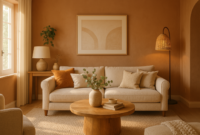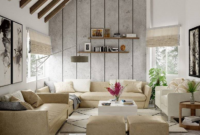Attractive and Easy to Copy Home Interior Design
In today’s fast-paced world, your home should be more than just a place to rest. It should be a sanctuary—a reflection of your personality, a hub of comfort, and a space that sparks joy. But designing a beautiful home often feels like a daunting and expensive endeavor, reserved only for those with hefty budgets or professional interior design knowledge.
The good news? You don’t need to be an expert or spend a fortune to create a stunning and inviting home. With the right guidance and a little creativity, anyone can craft a living space that is both attractive and incredibly easy to replicate.
Let’s dive into the essential elements, timeless ideas, and practical steps to design a beautiful, easy-to-copy home interior.
1. The Power of Simplicity
The foundation of any great design is simplicity. A clutter-free home automatically feels more spacious, more organized, and more serene. One of the most appealing styles that exemplifies simplicity is Scandinavian design.
Key characteristics of Scandinavian interiors:
-
Light, neutral color palettes (white, beige, gray)
-
Natural wood finishes
-
Minimalist decor
-
Functional furniture
-
Plenty of natural light
This aesthetic makes the space look airy and calm—perfect for creating a peaceful home environment. Plus, it’s incredibly easy to mimic using budget-friendly furniture and accessories from places like IKEA, H&M Home, or even thrift stores.
2. Choose a Cohesive Color Palette
One of the simplest ways to elevate your interior design is to stick to a cohesive color scheme. You don’t need to go all-white to be modern—try mixing warm neutrals like taupe, soft gray, creamy beige, and muted greens or blues.
To create visual harmony:
-
Limit your palette to 3–4 complementary colors.
-
Use lighter tones for walls and larger pieces like sofas or rugs.
-
Add darker or bolder shades in smaller accents—throw pillows, art, and vases.
Pro Tip: Use free tools like Canva or Coolors.co to generate color palettes based on your favorite photos or inspiration images.
3. Furniture that Works Double Duty
In smaller homes or apartments, every piece of furniture should serve a purpose—and ideally, more than one.
Some ideas:
-
A bench that doubles as storage
-
Coffee tables with built-in drawers or shelves
-
Beds with under-frame storage
-
Extendable dining tables
Multi-functional furniture not only saves space but also gives your home a smart, clean feel. Brands like Muji, Wayfair, and even Amazon Basics offer affordable and stylish options.
4. Smart Use of Textures
Texture adds depth and character to a room. Even in a monochrome space, combining various textures—think soft linens, coarse jute rugs, smooth ceramics, and rough wood—creates visual interest and warmth.

Try these texture layering tricks:
-
Mix soft throws and cushions with woven baskets
-
Use rattan or cane chairs with velvet upholstery
-
Introduce natural fibers like wool, cotton, or linen in curtains and rugs
This is a subtle and easy way to make any home feel cozier and more curated.
5. Statement Lighting
Never underestimate the power of good lighting. It’s one of the easiest ways to transform a room without structural changes. A stylish light fixture instantly becomes a design statement.
Types of statement lighting:
-
Pendant lights over the dining table or kitchen island
-
Sculptural floor lamps
-
Vintage chandeliers for an eclectic touch
-
Sleek, minimalist wall sconces
And remember: mix lighting sources. Combine ceiling lights with table and floor lamps to create cozy, layered lighting for different moods.
6. Decorate with Meaning
Rather than filling your space with random decor, aim for personal touches. This doesn’t mean you need to have a house full of DIY projects—but including items that tell your story makes your home feel warm and authentic.
Some ideas:
-
Travel souvenirs displayed as art
-
Family heirlooms or vintage finds
-
Gallery walls of your own photography
-
Framed quotes that resonate with you
Decorating with meaning is not only cost-effective but also creates a home that feels uniquely yours.
7. Greenery Goes a Long Way
Plants are one of the easiest ways to breathe life into any room—literally. They bring color, texture, and a calming effect. You don’t need to be a plant expert to enjoy the benefits of greenery.
Low-maintenance plant ideas:
-
Snake plant
-
Pothos
-
ZZ plant
-
Peace lily
-
Spider plant
If you’re truly not into plant care, realistic faux plants are widely available and just as decorative.
8. Open Shelving with Style
Open shelving is trendy and functional, especially in kitchens and bathrooms. It allows you to display beautiful objects and makes frequently used items more accessible.
Tips for styling shelves:
-
Group items in odd numbers (e.g., sets of 3 or 5)
-
Mix vertical and horizontal elements
-
Include books, small art, plants, and baskets
-
Use matching jars and containers for a clean look
Stick to a consistent color theme, and avoid overcrowding the shelves. Less is more.
9. Budget-Friendly Wall Art
Blank walls are missed opportunities. You don’t need to splurge on original art—there are countless affordable or free options:
-
Printable art from Etsy
-
DIY abstract paintings
-
Pressed flower frames
-
Fabric wall hangings
-
Digital art galleries
Use floating frames or clipboards for a modern gallery wall that’s easy to change as your style evolves.
10. Create Zones in Open Spaces
If you have an open-plan layout, use furniture and rugs to define areas. It helps break up the space and makes each part of the room feel intentional.
For example:
-
A large rug under the sofa anchors the living area
-
A bookshelf or console table can divide a dining and lounge space
-
A desk behind the sofa can create a work zone without walls
Zoning adds functionality and flow to your home—ideal for modern lifestyles.
11. Add Personality with Accessories
Small accessories can completely transform a room. Consider these quick, copy-worthy upgrades:
-
Switch out standard cabinet knobs with brass or ceramic ones
-
Use unique vases or candle holders as table centerpieces
-
Stack a few favorite coffee table books
-
Display a tray with perfumes, jewelry, or skincare in the bathroom
Accessories let you try trends without committing to major changes—and they’re easy to swap out by season.
12. Play with Mirrors
Mirrors are a well-known interior designer trick to make small spaces feel bigger and brighter. Placing a mirror across from a window maximizes natural light, while a large mirror leaning against a wall adds drama.
Try:
-
Round mirrors for a soft, modern look
-
Vintage mirrors for charm
-
Grid-style or paneled mirrors for an industrial feel
Mirrors also double as wall art, especially when framed creatively.
13. Think About the Flow
One of the most underrated parts of interior design is flow. Can you walk through your home without bumping into furniture? Does the room feel intuitive to navigate?
Try this:
-
Remove unnecessary furniture
-
Align major pieces like the sofa or bed with focal points (e.g., windows, TV)
-
Keep walking paths open
-
Don’t overcrowd corners or block natural light
Good flow makes your home more livable—and visually pleasing.
14. The Finishing Touches
Finally, bring it all together with ambiance. Even the most beautiful space can feel cold if it lacks warmth.
Consider adding:
-
Soft, warm bulbs in all lights
-
Scented candles or diffusers
-
A soft playlist or ambient music
-
Seasonal touches like cozy throws in winter or fresh flowers in spring
These finishing touches aren’t just aesthetic—they appeal to all your senses and make a house feel like a home.
Final Thoughts
Designing a home you love doesn’t have to be complicated or expensive. By focusing on simplicity, functionality, and personality, you can easily create a beautiful, easy-to-copy interior that feels curated but still livable.
Start small: rearrange what you have, declutter a surface, or add a plant to the corner of your room. Inspiration is everywhere, but your home should ultimately reflect you—your lifestyle, your tastes, your story.
The best home design isn’t the one with the most expensive furniture or the trendiest decor. It’s the one that feels like home.


